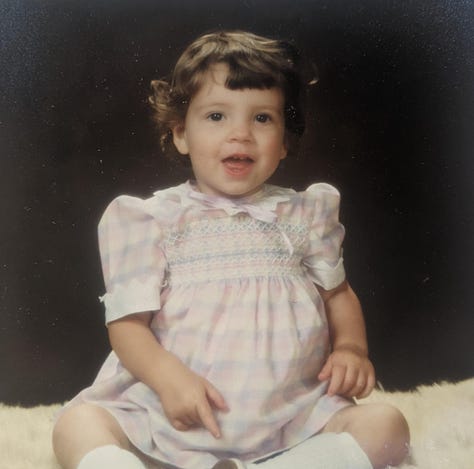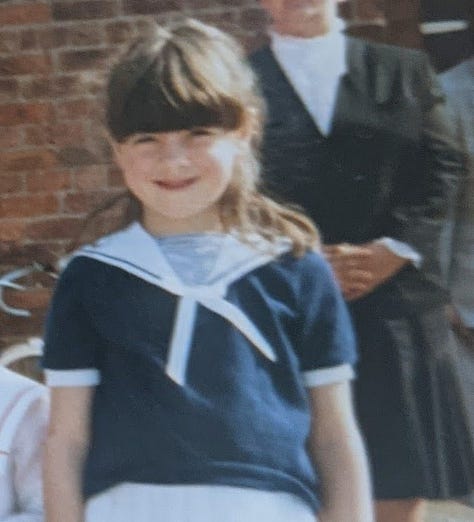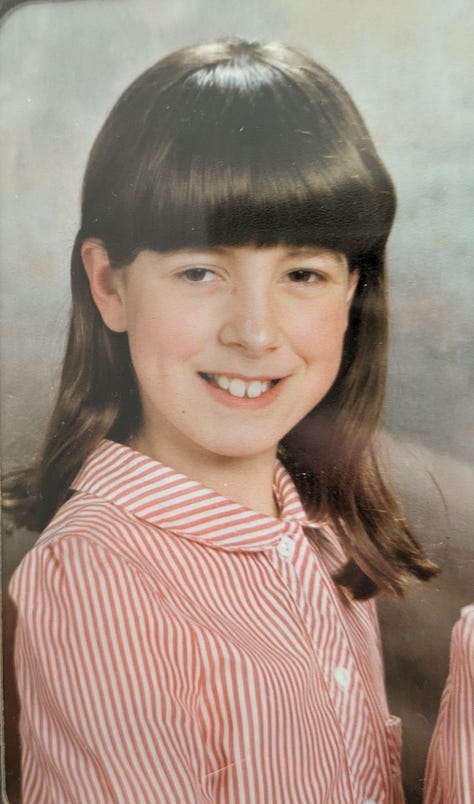Untangling Jesus
In part two of this mini series on reimagining Jesus (and with a hefty dose of fear and trembling), I attempt to give an answer to Jesus’ question “Who do you say that I am?”
In my last letter I invited you to join a tradition of imagining and reimagining Jesus that stretches right back to Jesus himself. I shared a story from one of my spiritual direction sessions where my directee bravely allowed herself to reimagine Jesus as a wolf - an image powerfully charged with meaning for her. I also shared some reflections on The Book of Longings in which Sue Monk Kidd imagines the kind of husband that Jesus could have been. I offered a gallery of art depicting Jesus in a multitude of ways and ended by suggesting that we consider Jesus’ question “ Who do you say that I am?” as an open question - one that opens onto a conversation and relationship in which we both name and are named by Jesus.
Through all this, I was careful not to share my own understanding of Jesus or give my own answer to the question “ Who do you say that I am?” Partly that was because the letter was already far too long. Mainly it was because it’s a topic that feels tender. As you will see, I have given - and been given - so many answers to that question that it’s a struggle to discern which one now feels honest and true. After I wrote this piece, I wondered if I was sharing too much too soon. Whether the vulnerability I felt in typing these words was a sign I wasn’t ready to share them. I considered not sending this letter to you. But I know that what helps me feel most safe to tell my story is other people finding the courage to share theirs. And what I want, perhaps most of all, is a world in which we help each other feel safe to tell our stories.
So here goes my attempt at writing truly about Jesus. Not The Truth About Jesus, which exceeds my stories and understanding, but the truth of my lived experience of Jesus, told as best I can on this particular day.
As a child I knew two Jesuses - one who loved and accepted me and one who scared and judged me. The one who loved and was loved by me was a kind friend, wise teacher, loving guide. This Jesus was trustworthy and safe, mysteriously but inextricably connected with God who I encountered as a loving presence with and around me. This Jesus came to me mysteriously through the between spaces far more than he was delivered to me through careful teaching. I encountered him less in Sunday school lessons and more in the kindness of adults who smiled with their eyes when they listened to me, less in the words of bedtime prayers and more in the quiet between those prayers and sleep, less in what was said in church and more in the acceptance and belonging I felt there.
I’m not sure I would have phrased it this way but this Jesus was the Christ to me. He was both a historical figure and a living presence: a teacher circumscribed in human form and a mystery playing in 10,000 places, endlessly and surprisingly turning up in the loving eyes and limbs of others, just as Gerard Manly Hopkins describes.1
The Jesus that scared me appeared later when I began to read the Bible alone in bed aged 9 or 10. He said there was a sin that would never be forgiven, called the Pharisees names, talked about people weeping and gnashing their teeth if they didn’t follow his teachings. I was intimidated by this Jesus, terrified that I’d accidentally committed the unforgivable sin or that I was like the Pharisees who Jesus didn’t seem to like very much. There were passages where I recognised the Jesus I knew (his emphasis on love and forgiveness, his healing touch, his care for the vulnerable) but I struggled to join the dots between his teachings or reconcile the gentle with the stern. I was confused and scared but also ashamed that I was confused and scared so I did what we all tend to do when we’re scared and ashamed: I hid. I told no one and tried to push away the nagging feeling that I had got Jesus all wrong and that he didn’t like me or my doubts. I wanted the fear to evaporate so I could get back to the Jesus I’d known before.



And so I held Jesus at a distance, my longing tinged with anxiety. I continued to trust in the loving presence I recognised as Divine but I was ambivalent about how that presence connected with Jesus.
In time, I came to know other Jesuses. Through studying Theology at university, I came to know the historical Jesus, the Jesus of the Church Fathers and Mothers, the Jesus of the mystics. Through friends, I came to know the Jesuses of different upbringings, denominations and religions. I found language to articulate my early experiences of Jesus and there was a relief in allowing the scary Jesus to recede into the background of this proliferation of Jesuses. I found a kindred spirit in Julian of Norwich whose Jesus spoke with a maternal gentleness I recognised and who spoke to my fears. As I gradually shared my experience with others I found that the shame and fear began to ease and new ways of being in relationship with Jesus emerged.
And yet neither the tensions nor my anxiety have completely gone away. Decades on, I've found peace but it ebbs and flows with a current that’s tied to forces in my psyche deeply rooted in my childhood. There’s still a scared little girl who lives inside me who is triggered by certain things I read, hear or see (especially the use of Jesus to support a judgemental, exclusivist agenda). I’m grateful for a spiritual director who helps that little girl feel safe to talk. My director has helped me identify the similarity between the frightening Jesus and my inner critic and to see that neither is effective, helpful or trustworthy as a guide. She encourages me to trust in the goodness of my connection with the Jesus I knew instinctively as a child and know now through my connection with the mystics and she has accompanied me in dialoguing with that beloved Jesus as I begin to untangle him from all the other Jesuses. The goal of this untangling is not so I can dismiss these other Jesuses but so I can create a space to consider, engage and be with them from a place of safety and stability. That way, even if I hear challenge in Jesus’ words, I won’t receive it fearfully.
Other things have helped too. First, people like Richard Rohr2 and Mark Gladman of Monk in Docs3 who do not shy away from the difficult passages but read them through a hermeneutic of love that often upends what, as a little girl, I had thought they were about. Such guides have encouraged me to approach the passages that perplex me with curiosity and openness. They invite me to let these passages be places of wondering as I ask the hard questions, trusting that if a question is honest and heartfelt it is never wicked.
Similarly, Ignatian practices that allow me to engage imaginatively with Jesus have helped to open another way of being with challenging passages. Trusting that my imagination is a holy space that doesn’t always take me away from reality but can help me go beneath the surface of things has brought insight, understanding and healing. You can find out more about one of these practices - Gospel Contemplation - here.
Something else that has been helpful is discovering that many of the passages that have been difficult for me are life-giving for others. For example, through my listening work as a spiritual director I have noticed that those who have been abused by the Church find comfort in Jesus’ harshness towards the rigidity of the Pharisees and other 1st century Jewish leaders. Letting go of thinking that every passage must be meaningful and comforting for me all the time and trusting that these teachings are for all of us, collectively, has helped me to integrate what I had previously wanted to discard.
Above all, what has offered a pathway out of fear has been letting Jesus be a mystery. I don’t mean mystery in an out-of-reach sort of way but in the sense of being inexhaustible. Acknowledging that Jesus is and always will be beyond any neat grasp allows me to hold all my ideas and questions lightly. What matters is my willingness to engage, not to answer correctly (the latter induces anxiety at best, smugness at worst). As I suggested in my previous essay, I’ve come to believe that when Jesus asks “Who do you say that I am?” it is a genuine question and an invitation to enter into a journey of relationship that has no final end (at least not in this life).
Perhaps all this makes it sound like I have it all figured out. I don’t. I still have questions about Jesus and sometimes that scared girl is all I feel. I’m learning to be a good mother to her and like Julian of Norwich who wrote down her revelations for the comfort of others, I’m writing this out in the hope that it might comfort another scared inner child who has never felt safe to voice their fears or doubts about the tradition they have grown up within. Perhaps there’s a Jesus you fear or perhaps it’s something else that is the source of your unease. Whatever it is, you are not alone and you are not wicked for having these thoughts. My hope is that you might find a safe person with whom you can talk. May their companionship take the sting out of your fear and may the welcome of their presence guide you home to trusting in the goodness of your own innate connection with the Divine.
With courage for your reimaginings,
Jen x
I share my stories to encourage you to tell your own - even if only to yourself.
Here are some questions for your own reflection…
How might you have answered Jesus’ question “who do you say I am?” at different stages of your life? What words or images might you have used?
What aspects of Jesus’ life or teaching do you struggle or wrestle with? Is this something you share or keep hidden? What is your hope for yourself?
What care does your inner child still need?
Rohr has published dozens of books and articles but the simplest way to begin is through signing up for his daily meditations. These are emailed each day via The Center for Action and Contemplation and you can sign up here.
Mark offers a huge range of free resources at https://monkindocs.podia.com/







Thanks, Jen. I appreciated how you articulated the different Jesuses in childhood and then how that has evolved over your life. Such important work to do for oneself and to open up for others.
I particularly loved this sentence: "I don’t mean mystery in an out-of-reach sort of way but in the sense of being inexhaustible." The word inexhaustible to explain how you are understanding "mystery," and especially connected with Jesus, is a gift to me that I'll keep pondering. Thank you! xx
I deeply resonated with this. Thank you for bravely sharing your experiences.